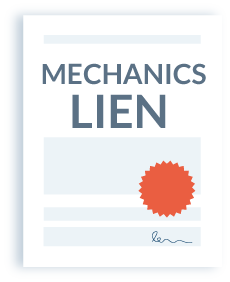
A mechanics lien is a very powerful tool that’s available to the construction industry in all 50 states, including Pennsylvania. If a contractor or other party is unpaid on a construction project located in the state, filing a Pennsylvania mechanics lien provides their best chance at guaranteeing payment.
Accordingly, Pennsylvania’s Mechanics Lien Laws of 1963 provide guidelines and requirements for filing, and the courts are strict about enforcing them. One small mistake in the lien filing process can be enough to kill a party’s lien rights on a project. Therefore, it’s essential for contractors and others filing a mechanics lien in Pennsylvania to be sure to get it exactly right.
Steps to file a mechanics lien in Pennsylvania
Unpaid contractors and suppliers can file a PA mechanics lien by following these steps:
- Fill out the Pennsylvania mechanics lien form.
Fill out the PA lien form completely and accurately. Make sure you are using a form that meets the guidelines and requirements set forth by Pennsylvania’s statutes. - File your lien claim with the county recorder.
Deliver your completed lien form to the prothonotary (county clerk) in the Pennsylvania county where the property is located, and pay the filing fee. - Serve a copy of the lien to the property owner.
After filing, you will need to deliver a copy of the mechanics lien to the property owner, and file an Affidavit of Service with the county clerk.

Before you file: Protect your PA lien right
Before you can file a mechanics lien in Pennsylvania, you should understand the state’s notice requirements.
Parties who have a direct contract with the property owner (in other words, GCs) aren’t required to provide a Pennsylvania Notice of Furnishing in order to file a lien. However, this preliminary notice may be required from anyone else who is not under direct contract with the property owner.
Sending preliminary notice is only required in cases where the project is worth more than $1.5 million AND the property owner chose to file a Notice of Commencement in the State Construction Notice Registry.
Preparing the Pennsylvania mechanics lien form
 Download the PA mechanics lien form
Download the PA mechanics lien form
First, you’ll need to be sure that you are using the correct mechanics lien form. The requirements are fairly strict, so you need to be sure that your document meets all the requirements, and contains all the pertinent information. Without the right form, your claim will be rejected at the recorder’s office right off the bat. There are a lot of resources out there that offer mechanics lien forms, but there’s no guarantee that they are reliable or accurate.
Download free, Pennsylvania Mechanics Lien forms
Levelset’s forms were created and reviewed by construction attorneys and payment experts; thousands of Pennsylvania contractors and suppliers have successfully used these forms to get paid.
Filling out the lien claim
There’s isn’t a whole lot of information required on the Pennsylvania mechanics lien form itself, but it must contain the following information:
1. Lien claimant information
This first section is an easy one, this is all of your relevant information. Be sure not to mess this part up. Provide your full name, address, and role on the project (i.e., subcontractor, supplier, equipment lessor, etc.). If you are filing on behalf of a company, make sure that the full, registered business name is used, along with the business designation (LLC., Inc.).
2. Property owner
The mechanics lien attaches to the property itself, but you still must identify the property owner for filing and indexing purposes. Be sure to get this part right, this is key to properly filing your lien claim. Sometimes, there are situations where this can prove more challenging than expected. There could be multiple owners, the property could have been sold or transferred during the project, or any other number of issues. How to Find the Property Owner on a Construction Project should be a useful resource.
3. Date of completion of work
This would simply be the last date that you, the claimant, provided labor or materials to the project. However, this doesn’t include any small repairs, “call-backs,” or minor punchlist work. Once your work is considered “complete” that’s not only the date that should be entered here but also starts the clock on your lien claim filing deadline as well.
4. Hiring party
For this part, unless you are the general contractor (or other parties who directly contracted with the owner), you’ll need to provide the name and address of your customer. This information should be readily available in the contract documents.
5. Dates that required notices were sent
If you were required to send a preliminary notice, then you must provide the date that you sent your notice. Additionally, a Notice of Intent to Lien (discussed below) is also required before filing your lien claim. Be sure to include the date this notice was sent out as well.
6. Identification of contract and a general statement of labor & materials furnished
If the labor or materials were furnished pursuant to a contract, this section should provide the original contract price, identify the contract (which should be attached), and a general statement fo the labor or materials provided. If, however, you weren’t working under contract, then you should provide a detailed statement of the kind and character of the labor or materials provided, along with the prices charged for each one.
7. Services were provided under a contract for an agreed-upon sum
If the claim is being filed pursuant to a contract for an agreed-upon sum (aka lump-sum) the claimant must identify and reference the contract and price, along with the description of labor and/or materials provided above. If the services provided were not under a contract with an agreed-upon price, the claimant should attach a detailed description of the labor and materials provided along with the corresponding prices charged for them.
8. Amount of the claim
This is number should be the unpaid amount under the contract terms or the reasonable value of the labor or materials provided to the project. Any debts unconnected to the actual construction, improvement, repair or alteration shouldn’t be added to this amount. That means no attorney’s fees, collection costs, or any accrued interest. Note, that mechanics lien rights are available for outstanding debts that are over $500.
9. Description of the property
Pennsylvania lien law requires a “description of the property claimed to be subject to the lien as may be reasonably necessary to identify them.” This doesn’t mean it needs to be a full legal description of the property. But that also means that a simple street address may not suffice. For this section, the more information provided, the better. Here’s an article to help you get started: Researching the Legal Property Description. Or you can download our Legal Property Description Cheat Sheet.
Recording your Pennsylvania lien
 Deadline to record
Deadline to record
There are strict deadlines when it comes to filing a Pennsylvania mechanics lien. Like the vast majority of states, this timeline may not be extended for any reason. Lien claims must be filed within 6 months of the date of the last work or materials supplied. Remember, as we stated earlier, this doesn’t include any minor or trivial work.
This is when your contract is considered complete. For a deep dive on this issue, you can read our article: Pennsylvania Mechanics Lien Law: When Does the Clock Start Ticking?
This can also be particularly tricky to calculate if you are a material supplier: What is the time frame in PA for a material supplier to file a lien after delivery of materials?
The notice of intent to lien
In addition to any preliminary notices that may be required, the state of Pennsylvania also requires a Notice of Intent to Lien be sent before filing a lien claim. This must be sent to the owner at least 30 days before filing. If you’re crunching the numbers, that means that this notice must be sent within 5 months of the last date of furnishing labor or materials to the project.
A common misconception is that this notice somehow affects the deadline to file the lien claim, which it doesn’t. Yet this question has popped up in our Ask an Expert Center before: If a notice of intent is given to a customer. Does this extend the days that we have in order to file a mechanics lien?
Finding the correct prothonotary
In order to perfect your lien claim, it must be filed in the prothonotary’s office of the county court where the property is physically located. A “prothonotary” is just an old-school term for the chief clerk of the court. If the property is located in more than one county, then the claim should be filed in both.
Each county can have different form requirements, filing fees, and some require a Certificate of Compliance to be attached as well. It’s important that you contact that county’s office ahead of time to be sure that you are prepared to file your claim right, the first time around. Here are a few Essential Questions to Ask the County Recorder’s Office. In an effort to make this process a bit easier, we’ve put together a list of every county prothonotary’s office:
Filing options: in person, by mail, or electronically
The best bet to ensure that the lien gets delivered and recorded in a timely fashion is to go down to the office yourself. This is the best way to fix and deficiencies you might encounter during the filing process. Also, when filed in person, the document is considered filed that day, if you got there early enough. If mailing, be sure to include fees for at least one extra copy, and a self-addressed, stamped envelope so that you can properly serve the owner, and keep one for your records as well.
Some counties in Pennsylvania allow for documents to be recorded electronically. If you elect to take the electronic route, you will likely need to register with some e-filing service and scan copies of your lien claim. Make sure that the scanned copy meets all the size and formatting requirements before sending it out to the prothonotary’s office.
Serving notice of the lien claim
Once your lien is filed, you still need to take steps to secure your lien rights. A Notice of Lien Claim must be served on the property owner within 1 month of filing the claim. This can be either personal service or posted conspicuously on the job sight.
After service is accomplished, an Affidavit of Service (proof of notice) must be filed in the same office where the lien claim is filed. This is a mandatory requirement, failure to meet this deadline will invalidate your lien.
What to do after filing a Pennsylvania mechanics lien
A. Foreclose on the lien
If the non-payment issue is still not resolved, the lien may need to be enforced. In order to do so, the claimant must eventually obtain judgment upon the filed mechanics lien. A complaint to enforce your lien claim must be made within 2 years of filing the claim. Afterward, the judgment must be entered within 5 years from the date the original claim was filed, or it will expire.
The process can tend to get a little intimidating; there’s a great breakdown of this in our Ask an Expert Center: Now that my lien has been filed, what happens next? Does it have to go to court to obtain judgment? Who does the filing in Superior Court?
If payment isn’t made after a lien is filed, there’s another step that claimants can add to compel payment without filing a lawsuit: a Notice of Intent to Foreclose. This document essentially acts as a final warning. It states that if payment isn’t made and made soon, a lawsuit will be filed to enforce the lien claim. Plus – it’s an inexpensive and relatively risk-free option. Considering the risk and expense of litigation, many claimants have found it’s a good idea to send a Notice of Intent to Foreclose before actually foreclosing their lien.
B. Release (or cancel) the lien claim
There is no statute that specifically states when and how the lien should be released. However, once the debt has been paid, the owner will likely request that you file a PA mechanics lien release form. This should be filed in the same prothonotary office where the initial lien claim was filed.
Additional Pennsylvania resources
- Pennsylvania Construction Payment Help Hub
- Prevailing Wages in Pennsylvania: What Contractors Need to Know
- Blog posts on Pennsylvania construction payment topics
- Ask a legal or payment expert a Pennsylvania construction payment question


 Download the PA mechanics lien form
Download the PA mechanics lien form

 Deadline to record
Deadline to record